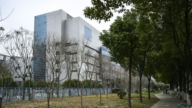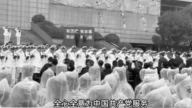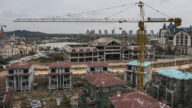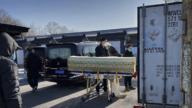【新唐人2011年8月5日讯】铁道部最近公布京沪高铁第一个月的上座率为107%,网友广泛质疑资料有假,因为人们看到京沪高铁空座率很高。铁道部随后解释说,这个资料是把中途上下旅客的数字重复叠加计算而来。专家指出这种计算方法有问题,认为这是“大跃进”式的笑话再现。
铁道部网站发布消息,京沪高铁运营一个月以来,共行驶动车5542列,运送旅客526万人,平均上座率107%。民众大惑不解,因为和看到的情况相差甚远。据一位7月26号乘坐高铁的旅客反映说,二等座车厢里最多不超过30%的上座率,一等座人更少,商务座只有3个座位有人。107%的数据从何而来?
而铁道部随后回应说,高铁列车中途停站,旅客有上有下,席位可以重复使用,所以上座率超过100%并不一定超员。铁道部的计算方法是,列车上座率等于购票上车的旅客人数除以列车定员。也就是对同一个座位,不同旅程的乘客进行叠加。
据《新京报》引述湖北省统计局副局长叶青的看法,铁道部算法有水分,不客观。从经济角度来讲,107%的上座率听上去挺唬人,但是实际上没资料上那么多人。叶青提出,科学的计算方法应该是,“有效上座率”等于“有效里程数”除以“座位里程数”。“有效里程数”指的是某座位有人乘坐时列车行驶的里程数;“座位里程数”指的是列车全程的里程数。
据中国日报引述北京交通大学铁路专家赵坚的话说,美国“全国铁路客运公司”(Amtrak)及大多数美国航空公司都是用“乘客里程”(乘客总里程乘以乘客使用的座位数)除以“座位里程”(里程数乘以总座位数)来计算上座率。这种方法和叶青的方法是一致的。
“中南大学”城市轨道交通研究所教授王成立指出,铁道部这种计算方法属于“中国特色”,可以和“亩产万斤”的笑话相媲美。中共当局一贯喜欢吹牛皮,并且还要蒙上科学的面纱。
王成立:“中国的特色你应该知道。五八年‘大跃进’就是那样,亩产一万斤,他亩产五万斤,另外一个亩产二十万斤,那怎么统计出来的?还有国内著名大师都论证了,这是可行的。什么光合作用,能量守恒。中国的笑话太多了。不要信那些东西。”
原“长春轨道客车股份有限公司”工程质量管理工程师魏景翌表示,按照铁道部这种算法,外人永远不可能知道高铁真正的座位使用率是多少,这只能是愚弄老百姓的一种算法。魏景翌认为,铁道部想吹嘘高铁上座率高,但是他的做法欲盖弥彰。
魏景翌:“极力的想证明上座率有多高。其实从反面证明应该是上座率不高。因为过去来讲中国铁路没有人提这个指标。因为超员这种状态是中国铁路客车的常态。”
据《新京报》8月2号的实地调查,京沪高铁G141次和G17次的检票口进站人数,分别为640人和634人,而列车定员分别为1028人和1005人。用进站人数除以列车定员,可计算出G141和G17当天出发时的上座率为62%和63%。
新唐人记者秦雪、薛莉采访报导。
=====
Railway Great Leap Forward
China’s Ministry of Railways announced that during
the first month operation of Beijing-Shanghai high-speed rail,
the seat occupancy rate was as high as 107%.
However, the public suspects the figure to be falsified.
Eyewitnesses say that the trains on Beijing-Shanghai line
were not filled.
The Ministry of Railways later explained that
the figure was calculated by accounting for passengers
getting on the trains midway.
Experts say that the calculation is flawed, and
this is another rail great leap forward.
According to The Ministry of Railways’ official website,
in the first month of the Beijing-Shanghai line’s operation,
There were a total of 5,542 train trips,
transporting 5.26 million passengers,
with an average seat occupancy rate of 107%.
The difference between the data and the reality
has left the public wondering.
As per a passenger, who took a high-speed train on July 26,
second-class cars had an occupancy rate of less than 30%.
The rate was even lower for first class cars.
There were only 3 passengers in the business-class cars.
Where did the 107% occupancy rate come from?
The Ministry of Railways responded later that
as trains make stops midway, passengers get on and off.
Thus, same seats can be used by more than one passenger.
Even if the occupancy is over 100%,
the train might not be full.
The calculation used by the Ministry is:
Seat occupancy equals to
the number of tickets sold divided by total number of seats.
The same seats are accounted for several times.
Beijing News quoted Hubei Province Statistics Bureau
Deputy Director Ye Qing that
The calculation used by the Ministry of Railways
is not objective and has flaws.
From an economic point of view,
a 107% occupancy rate sounds like an overstatement.
Ye Qing said that the correct calculation should be
Effective seat occupancy equals to
effective millage divided by seat millage.
Effective millage is the distance travelled
while the seats are occupied,
Seat millage is the total distance travelled by the train.
China Daily quoted Beijing Jiaotong University
railway expert Zhao Jian saying that
America’s Amtrak and most of American airline companies
divide passenger millage by seat millage to calculate occupancy.
This method is consistent with Ye Qing’s suggestion
Central South University Institute of Urban Rail Transit
professor Wang Chengli pointed out that
The Ministry’s calculation is a “Chinese characteristic,"
comparable to “an acre of land producing tons of crop."
The Chinese Communist Party (CCP) enjoys exaggeration
with the appearance of being scientific.
Wang Chengli: You know the “Chinese characteristic",
similar to the stories of the Great Leap Forward in 1958,
such as one acre of land produced one ton of crops.
Some even claimed one acre could produce 20 tons.
How were they calculated?
Many renowned experts in China even proved it possible,
with explanation of photosynthesis and energy conservation.
This happens often with the CCP.
So, do not believe them.
Former Changchun Railway Vehicles Co., Ltd
Project Quality Management Engineer Wei Jingyi said that
according to the Ministry of Railways’ calculation,
the public will never know the real occupancy rate.
This is a way to fool the public.
Wei believes that the Ministry is trying to boast a high
occupancy rate, to no avail.
Wei Jingyi: they (Ministry of Railways) want
to prove a high occupancy rate.
However, they indirectly proved that the rate is low.
In the past, occupancy rate was never used,
because Chinese trains are always over-crowded.
According to a field survey done by Beijing News on Aug. 2,
the numbers of travelers on Beijing-Shanghai high speed trains
G141 and G17 were 640 and 634 respectively,
However, the train capacities were 1028 and 1005, respectively.
According to this data, the occupancy rates of G141 and G17
on Aug. 2 were 62% and 63% respectively.
NTD reporters Qin Xue and Xue Li.

























